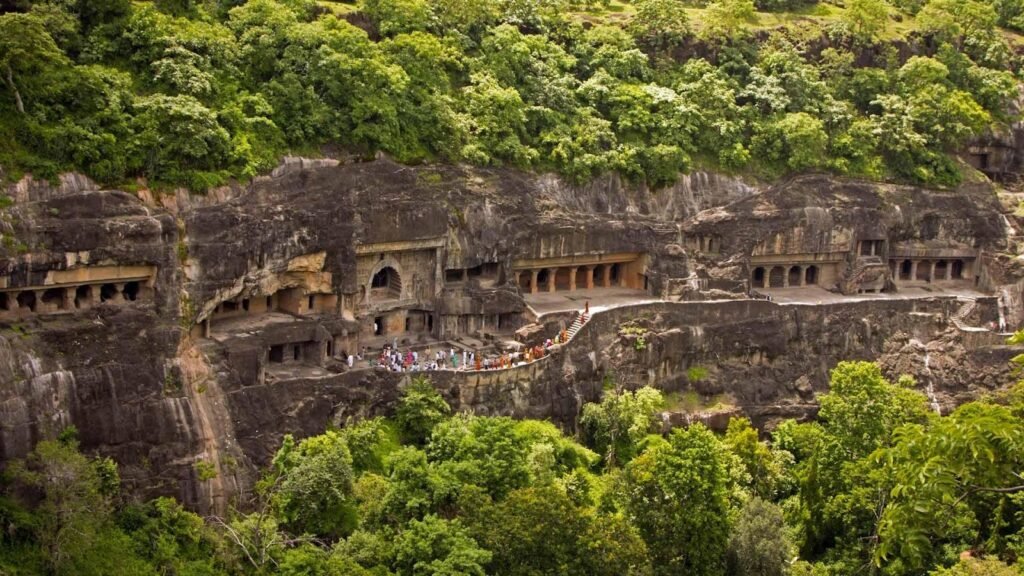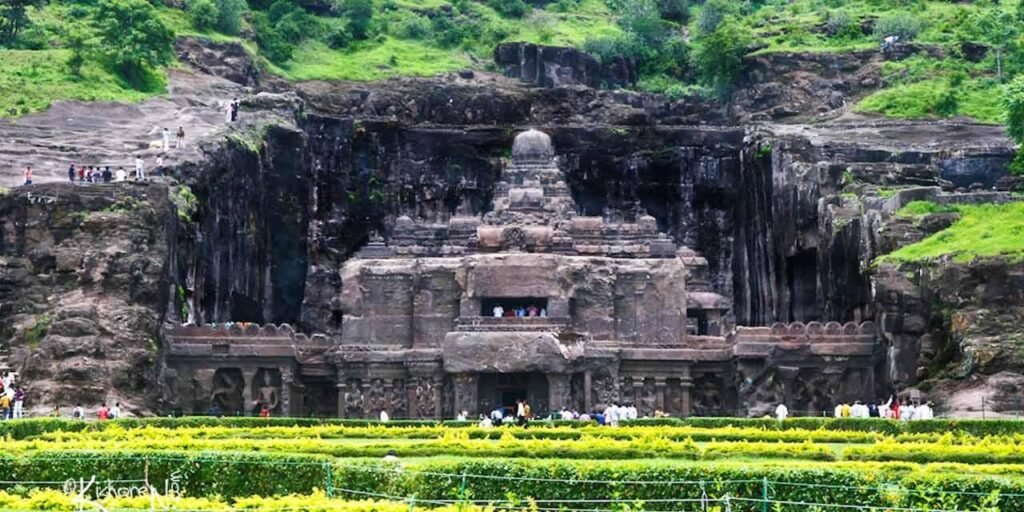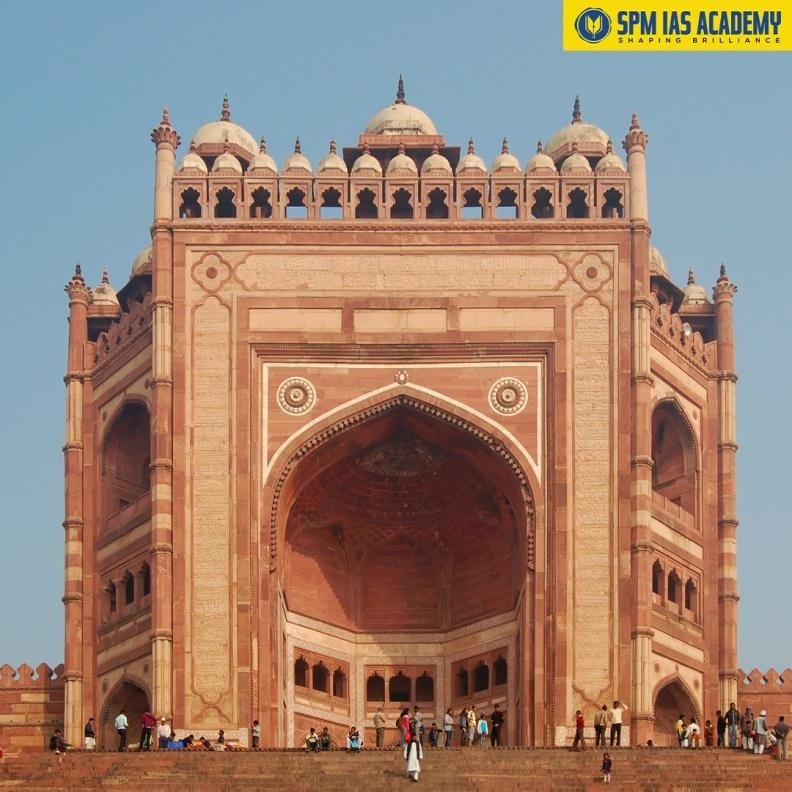India is a land of rich cultural heritage, architectural marvels, and natural wonders. UNESCO World Heritage Sites in India represent the country’s history, art, religion, and biodiversity. In 2025, India has 40+ UNESCO World Heritage sites, ranging from ancient monuments to pristine natural reserves. In this article, we have discussed the top 10 UNESCO World Heritage Sites in India, along with their history and interesting facts.
For UPSC CSE, APSC CCE, and other State PCS exams, knowledge of these sites is crucial. It is important for General Studies (GS) Paper I & III, especially under Indian History, Art & Culture, Geography, and Environment. These sites not only reflect India’s historical and architectural brilliance but also its ecological diversity, making them essential for answer writing, prelims MCQs, and interview.
Which are the Top 10 UNESCO World Heritage Sites in India?
1. Taj Mahal, Uttar Pradesh

Year of Recognition: 1983
Type: Cultural
- Mughal Emperor Shah Jahan built the Taj Mahal in memory of his beloved wife Mumtaz.
- He built it between 1631 and 1648 AD. It is located in Agra, Uttar Pradesh and is a symbol of eternal love.
- It is one of the most important UNESCO World Heritage Sites in India.
- Ustad Ahmad Lahori made its design and used white marble and other semi-precious stones.
- It is an iconic example of Mughal architecture.
Additional Facts:
- There are four free standing Minarets surrounding the Tomb.
- The complex also includes the main gates, a mosque, a guesthouse and surrounding gardens.
- It attracts over 7 million visitors annually.
- The Taj Mahal appears pink at sunrise and golden at sunset.
- It is often called one of the Seven Wonders of the World.
2. Ajanta and Ellora Caves, Maharashtra

Year of Recognition: Ajanta (1983), Ellora (1983)
Type: Cultural
- These rock-cut caves are masterpieces of ancient Indian art and architecture. Ajanta Caves are famous for Buddhist murals, while Ellora showcases Buddhist, Hindu, and Jain temples.
- The caves date back to 2nd century BCE – 10th century CE, reflecting India’s religious harmony.
Ajanta Caves, Maharashtra:

- The caves at Ajanta represent a collection of Buddhist art from two periods.
- The first monuments date to the 2nd and 1st centuries BCE. Followers of Theravada Buddhism created these caves.
- In the 5th and 6th centuries, the followers of Mahayana Buddhism during the Vakataka dynasty added more caves.
- The monuments are masterpieces of Buddhist are and exerted strong artistic influence in India and the broader region, especially in Java.
Ellora Caves, Maharashtra:

- The Ellora Caves consist of 34 temples and monasteries carved into a 2 km (1.2 mi) long basalt cliff.
- They were constructed between the 7th and 11th centuries during the Rashtrakuta Empire.
- The caves were built by followers of Buddhism, Hinduism, and Jainism, showcasing the religious harmony and tolerance of that era.
- The most magnificent structure is the Kailasa Temple, renowned for its elaborate sculptures, intricate carvings, and vibrant paintings.
- Ellora represents an exceptional example of ancient Indian rock-cut architecture and cultural coexistence.
Additional Facts:
- Ellora’s Kailasa Temple is carved from a single rock.
- The murals in Ajanta are considered the finest surviving examples of ancient Indian painting.
3. Qutub Minar, Delhi

Year of Recognition: 1993
Type: Cultural
- The Qutub Minar, standing at 73 meters, is the tallest brick minaret in the world.
- Built by Qutb-ud-din Aibak in the 12th century, it marks the beginning of Islamic rule in India. The complex also includes Quwwat-ul-Islam Mosque and other medieval monuments.
- The Qutb Minar Complex features several early Islamic monuments built during the 13th and 14th centuries, marking the rise of the Delhi Sultanate.
- It includes the Qutb Minar, a towering 72.5 m (238 ft) high minaret, symbolizing the beginning of Islamic rule in India.
- The complex also houses the Alai Darwaza, an exquisite gateway showcasing Indo-Islamic architectural brilliance.
- The Quwwat-ul-Islam Mosque was constructed using stone pillars repurposed from earlier Hindu temples, reflecting the cultural transitions of that period.
- Other notable structures include the Iron Pillar, famous for its rust-resistant composition, along with several tombs and smaller monuments surrounding the site.
Interesting Facts:
- The minaret has five distinct stories, each marked by a projecting balcony.
- It is a fine example of Indo-Islamic architecture.
4. Humayun’s Tomb, Delhi

Year of Recognition: 1993
Type: Cultural
- Built in the 1560s by Empress Bega Begum, Humayun’s Tomb is the first garden-tomb in India and a precursor to the Taj Mahal.
- It combines Persian and Mughal architectural styles and is surrounded by charbagh (four-part) gardens.
- It inspired the design of Taj Mahal.
- The tomb complex houses the graves of various Mughal royals.
5. Sun Temple, Konark, Odisha

Year of Recognition: 1984
Type: Cultural
- The Sun Temple at Konark is shaped like a chariot of the Sun God, with 12 pairs of stone wheels.
- Built in the 13th century by King Narasimhadeva I of Eastern Ganga dynasty, it is an example of Kalinga architecture.
- Other decorative motifs include lions, musicians, dancers etc.
- It is famous for its intricate erotic and mythological carvings.
6. Kaziranga National Park, Assam

Year of Recognition: 1985
Type: Natural
- It is on the floodplains of Brahmaputra River in Assam. It got recognition as a national park in 1974.
- Kaziranga National Park is home to the one-horned rhinoceros and many endangered species.
- It is in between the Brahmaputra river on the north and the Karbi Anglong mount on South.
- The park covers 430 sq km and is a UNESCO Natural Heritage Site.
Additional Facts:
- 1905 – as proposed Reserved Forest
- 1908 – declared as Reserved Forest
- 1916 – declared as Game sanctuary
- 1938 – opened for visitors
- 1950 – declared as Wildlife Sanctuary
- 1975 – became the first protected area equipped with wireless network in Assam
7. Sundarbans National Park, West Bengal

Year of Recognition: 1987
Type: Natural
- The Sundarbans is the largest mangrove forest in the world, home to the Royal Bengal Tiger.
- It is a UNESCO World Heritage Site and a critical biodiversity hotspot.
- The Sundarbans National Park incorporates the Indian part of the Sundarbans delta of the Ganges and Brahmaputra rivers.
- It is the world’s largest and most diverse mangrove forest, accommodating around 78 recorded mangrove species.
- The park is recognized as a biodiversity hotspot, supporting a wide variety of flora and fauna.
- It is home to a significant population of Bengal tigers, along with the Irrawaddy dolphin and the Ganges river dolphin.
- The region also shelters numerous bird species, sea turtles, and other rare wildlife.
- The Bangladesh portion of the Sundarbans is designated as a separate UNESCO World Heritage Site.
Additional Facts:
- The forest spans India and Bangladesh.
- It acts as a natural barrier against cyclones.
8. Fatehpur Sikri, Uttar Pradesh

Year of Recognition: 1986
Type: Cultural
- Fatehpur Sikri served as the capital of the Mughal Empire under Emperor Akbar for about a decade during the latter half of the 16th century.
- The city is known for its blend of Mughal and Rajput architectural styles.
- In 1585, Lahore became the Mughal capital, leading to the gradual abandonment of the city.
- The site features an extensive collection of monuments, palaces, and temples built in the distinct Mughal architectural style.
- Notable structures include the Jama Masjid, its grand gateway the Buland Darwaza, the elegant Panch Mahal, and the revered Tomb of Salim Chishti.
- Fatehpur Sikri stands as a demonstration to Mughal urban planning, architectural brilliance, and cultural synthesis.
9. Mahabalipuram Monuments, Tamil Nadu

Year of Recognition: 1984
Type: Cultural
- The Shore Temple and Pancha Rathas in Mahabalipuram showcase Pallava architecture from the 7th–8th century CE.
- The rock-cut temples are masterpieces of ancient sculptural art.
- The Group of Monuments at Mahabalipuram features various types of ancient architectural structures.
- These include the Rathas, which are chariot-shaped temples such as the Dharmaraja Ratha.
- The site also contains Mandapas, or rock-cut cave temples, showcasing intricate carvings and mythological themes.
- Among the highlights is the giant rock relief known as the Descent of the Ganges, one of the largest bas-reliefs in the world.
- The iconic Shore Temple (pictured) stands as a masterpiece of Pallava architecture overlooking the Bay of Bengal.
- Other temples and archaeological remains further illustrate the artistic excellence of 7th–8th century South India.
Interesting Facts:
- Shore Temple is one of the earliest stone temples in South India.
- Mahabalipuram was a major port city during the Pallava dynasty.
10. Great Himalayan National Park, Himachal Pradesh

Year of Recognition: 2014
Type: Natural
- Initially constituted in 1985 and became a National Park in 1999, this park preserves high-altitude ecosystems, including snow leopards, Himalayan brown bears, and endemic flora.
- The Great Himalayan National Park is in Banjar sub-division of Kullu district, Himachal Pradesh, in the far western Himalayas. It represents Himalayan biodiversity at its best.
- Moreover, the Great Himalayan National Park covers a diverse range of habitats, from alpine peaks above 6,000 m (20,000 ft) to alpine meadows and riverine forests below 2,000 m (6,600 ft).
- Furthermore, the park features 25 distinct forest types, representing a rich ecological variety.
- It supports an abundant floral and faunal diversity, including numerous species of birds, mammals, reptiles, and insects.
- Overall, the park is a crucial habitat for endangered species such as the western tragopan and the musk deer.
Additional Facts:
- Covers over 1,171 sq km of pristine wilderness.
- Ideal for research on Himalayan ecology and climate change.
What are UNESCO World Heritage Sites?

- UNESCO recognizes places of outstanding cultural, natural or mixed significance to humanity as World Heritage Sites.
- Cultural sites: monuments, historic cities, temples, or artistic achievements that reflect human creativity and heritage.
- Natural sites: forests, mountains, lakes, or habitats that are exceptional in terms of biodiversity, geological formations, or natural beauty.
- Mixed sites are those that have both cultural and natural importance.
- The 1972 World Heritage Convention recognizes sites of “outstanding universal value”. They are important for all humanity, not just the country where they are located.
- The designation of UNESCO World Heritage Site helps in protection, conservation, and promotion of tourism while preserving heritage for future generations.
- The UNESCO World Heritage List features a total of 1,248 properties recognized for their outstanding universal value.
- These sites represent both cultural and natural heritage deemed significant by the World Heritage Committee.
- The list includes 972 cultural sites, 235 natural sites, and 41 mixed properties located across 170 States Parties.
- As of October 2024, a total of 196 States Parties have ratified the World Heritage Convention, reaffirming their commitment to global heritage preservation.
- With 61 selected areas, Italy is the country with most sites. China with 60 sites is at second and Germany with 55 sites at the third rank.
What are the criteria for selection of UNESCO World Heritage Site?
To get this recognition, sites must be of outstanding universal value and meet at least one out of ten selection criteria.
- Until the end of 2004, World Heritage sites were selected on the basis of six cultural and four natural criteria.
- With the adoption of the revised Operational Guidelines for the Implementation of the World Heritage Convention, only one set of ten criteria exists.
- Selection Criteria:
- Represents a masterpiece of human creative genius
- Exhibiting important interchange of human values over a time or across culture, on the developments in architecture, technology, monumental arts, town planning and landscape design.
- Unique or exceptional testimony to a cultural tradition or civilization which is living or has disappeared.
- Outstanding example of a type of building, architectural or technological ensemble or landscape which illustrate significant stages of human history.
- Outstanding example of a traditional human settlement, land-use or sea-use, representing a culture, human interaction with environment especially when it has become vulnerable under the impact of irreversible change.
- Directly or tangibly associated with events/living traditions with ideas or beliefs, artistic and literary works of outstanding universal significance.
- Containing superlative natural phenomenon or areas of exceptional natural beauty and aesthetic importance.
- Outstanding examples representing major stages of earth’s history, including record of life, on-going geological processes in the development of landforms, significant geomorphic or physiographic features.
- Outstanding examples representing on-going ecological, biological processes in the evolution and development of terrestrial, fresh water, coastal and marine ecosystems and communities of plants and animals.
- Most important and significant natural habitats for in-situ conservation of biological diversity, including those containing threatened species of outstanding universal value from the point of view of science or conservation.
UNESCO World Heritage Sites in India:
- India has 44 UNESCO World Heritage Sites in total.
- Of these, 36 sites are in the cultural category, 7 are in the natural category, and 1 is in the mixed category – the Khangchendzonga National Park.
- India ranks sixth worldwide in terms of the total number of UNESCO World Heritage Sites.
- The first Indian sites inscribed on the UNESCO list in 1983 were:
- Ajanta Caves
- Ellora Caves
- Agra Fort
- Taj Mahal
- The most recent addition in the list of UNESCO World Heritage Sites in 2025 is the Maratha Military Landscapes of India.
India’s UNESCO World Heritage Sites are evidence to the country’s cultural richness, architectural brilliance, and ecological diversity. For UPSC aspirants, knowledge of these sites is crucial for General Studies, Current Affairs, and Essay papers, as well as personality tests. Knowledge of these sites helps in understanding India’s historical evolution, artistic achievements, and environmental significance.
Sources:
- https://www.unesco.org/en/world-heritage
- https://kazirangasafari.in/
- https://unesco.org.uk/resources/basic-texts-of-the-1972-world-heritage-convention-dec-23-edition
Article Links Table
Article Links
Click on any title below to open the article in a new tab.
As of 2025, India has 44 UNESCO World Heritage Sites, including cultural, natural, and mixed properties recognized for their outstanding universal value.
The Ajanta Caves and Ellora Caves in Maharashtra were among the first Indian sites inscribed on the UNESCO World Heritage List in 1983.
Maharashtra has the highest number of UNESCO World Heritage Sites in India, including Ajanta Caves, Ellora Caves, and the Victorian Gothic and Art Deco Ensemble of Mumbai.
The Khangchendzonga National Park in Sikkim is India’s only mixed site. It got recognition for both its cultural and natural heritage.
The Maratha Military Landscapes of India is the latest UNESCO World Heritage Site, highlighting the architectural and strategic legacy of the Maratha Empire.












